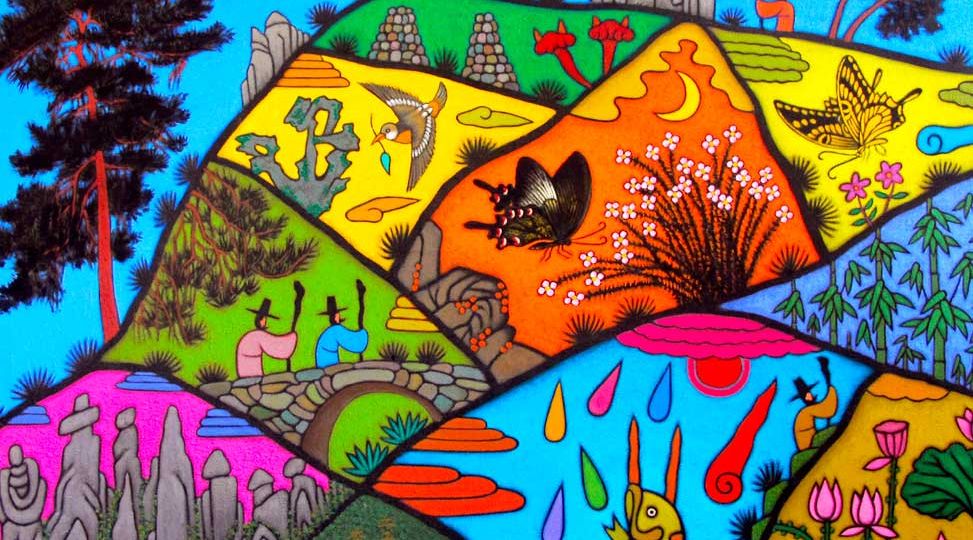
The Spectrum of Consciousness
Color Symbolism in the Typology of C. G. Jung
Download or listen to this article
Kiley Laughlin, October 7, 2015
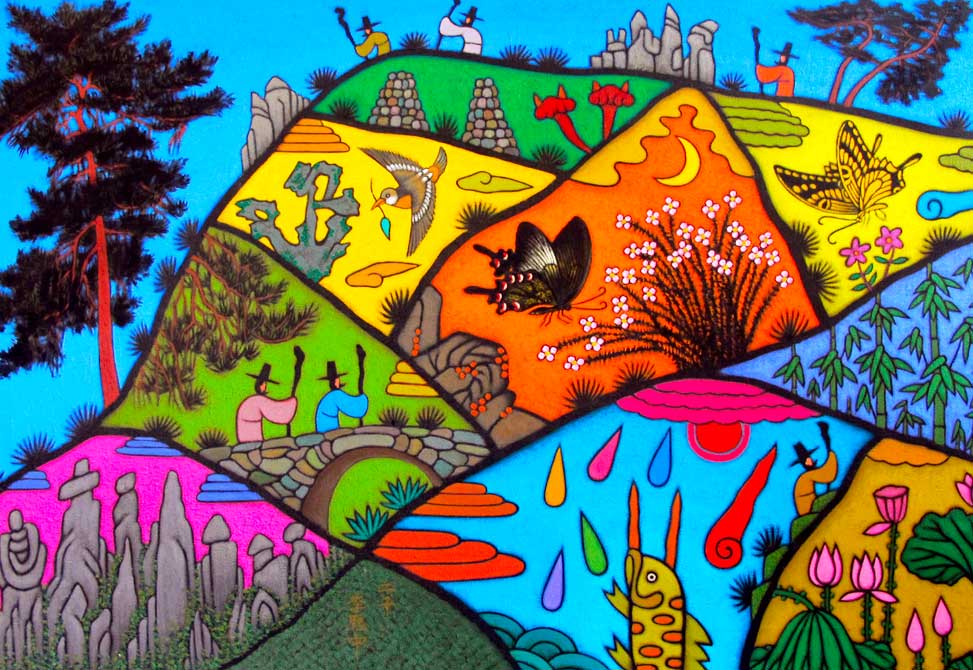
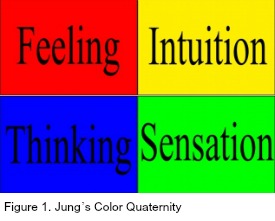
Psychologically it means that during the assimilation of the unconscious the personality passes through many transformations which show it in different lights and are followed by ever-changing moods. These stages precede the coming birth. (1956/1963, CW 14, para. 430)
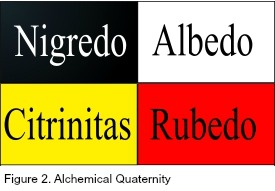
In Jung’s commentary on The Secret of the Golden Flower he included one of his own mandalas, which came from Liber Novus, image 105. Jung (1929) provided the following description of the image:
In the centre, the white light, shining in the firmament; in the first circle, protoplasmic life-seeds; in the second, rotating cosmic principles which contain the four primary colours [italics added]; in the third and fourth, creative forces working inward and outward. At the cardinal points, the masculine and feminine souls, both again divided into light and dark. (CW13, p. A6)
Over 20 years later, Jung (1950) provided additional commentary on the same image in his essay “Concerning Mandala Symbolism,” wherein he wrote:
In the center is a star. The blue sky contains golden clouds. … The circle enclosing the sky contains structures or organisms that look like protozoa. The sixteen globes painted in four colors [italics added] just outside the circle derived originally from an eye motif and therefore stand for the observing and discriminating consciousness. (CW 9i, para. 682)
In his second commentary Jung refrained from calling them primary colors. Author John Irwin (1994) has suggested that at some point in Jung’s career his understanding of the color quaternity evolved.
As we noted earlier, one form that the quaternity symbol takes in alchemy is the four colors linked to the stages of alchemical work—black, white, yellow, and red. But Jung points out that there is another quaternity of colors associated with the marriage of the king and queen of heaven—yellow, red, green, and blue. (p. 68)
Irwin’s observations are further elucidated by Jung’s 1933 commentary:
The quaternity in alchemy, incidentally, was usually expressed by the four colours of the old painters, mentioned in a fragment of Heraclitus: red, black, yellow, and white; or in diagrams as the four points of the compass. In modern times the unconscious usually chooses red, blue (instead of black), yellow or gold, and green (instead of white). The quaternity is merely another expression of the totality. These colors embrace the whole of the rainbow. The alchemists said that the appearance of the cauda pavonis, the peacock’s tail, was a sign that the process was coming to a successful conclusion. (1940, p. 48)
The Missing Fourth
Jung suggested that sometime within the last 500 years, between the end of the Middle Ages (500 C.E.–1500 C.E.) and the beginning of the Modern Era (1600 C.E.–2000 C.E.), the color symbolism corresponding to the four functions underwent a transformation within the western psyche, which implies a major restructuring of collective psychic contents. Regarding the alchemical quaternity, Jung (1956/1963) further noted that:
Four stages are distinguished, characterized by the original colours mentioned in Heraclitus: melanosis (blackening), leukosis (whitening), xanthosis (yellowing), and iosis (reddening). This division of the process into four was called the quartering of the philosophy. Later, about the fifteenth or sixteenth century, the colours were reduced to three, and the xanthosis, otherwise called the citrinitas, gradually fell into disuse or was but seldom mentioned. … Whereas the original tetrameria corresponded exactly to the quaternity of elements, it was now frequently stressed that although there were four elements (earth, water, fire, and air) and four qualities (hot, cold, dry, and moist), there were only three colours: black, white, and red. (CW 12, para. 333)
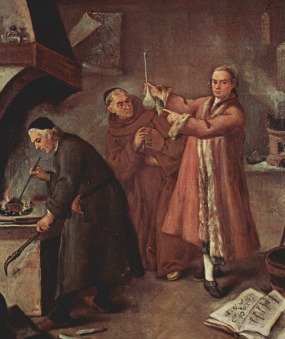
Thus, between 1929 and 1950—when he published “Concerning Mandala Symbolism”—Jung’s thinking on the color quaternity changed. As previously suggested, his re-visioning of the color scheme seems predicated on the symbolism expressed in the dreams and fantasies of individuals on the one hand and Jung’s intense study of Eastern philosophy and religion on the other. Jung’s propensity to connect things together was bolstered by his syncretistic impulse.
Dreams and Visions
Throughout his long career, Jung gathered a plethora of analytic and clinical material which he used to support his theories. He incorporated a good deal of case material into his papers, including “A Study in the Process of Individuation.” Jung originally presented this paper at the 1933 Eranos Conference in Ascona, Switzerland. Therein he first alluded to a color quaternity comprised of red, yellow, green, and blue. The paper dealt with a middle-aged female analysand, Miss X, who had reached an impasse in her life and found herself stuck. Her unconscious compensated for the inadequacies of her conscious attitude by producing elaborate archetypal dreams and fantasies. In addition to this imagery, she had a collection of 24 paintings that Jung viewed as charting the course of her individuation journey. It should be noted that Jung included one picture (i.e., Picture 9) from her collection in his commentary for The Secret of the Golden Flower. Jung encouraged Miss X to document her fantasies in an imagistic and aesthetic way, not unlike what he had done with his own Red Book material. During the span of their analytic sessions, Jung understood that colors could help activate the unconscious and encouraged her to creatively express them in pictures: “I also advised her not to be afraid of bright colours, for I knew from experience that vivid colours seem to attract the unconscious. Thereupon, a new picture arose” (CW 9i, para. 530). Miss X was later identified as one of Jung’s close colleagues, an American woman named Kristine Mann (1873-1945) (Kirsch, 2000, p. 65). Although we cannot say for certain, it seems that Mann began her analysis with Jung around 1928, which turned out to be a pivotal year in the development of Jung’s ideas. Her analysis with Jung apparently concluded in May 1938. Regarding the mandala pictures rendered by Mann, Jung (1934/1959) noted the same color quaternity:
This takes place in stages: a combination first of blue and red, then of yellow and green [italics added]. These four colours symbolize four qualities, as we have seen, which can be interpreted in various ways. Psychologically this quaternity points to the orienting functions of consciousness, of which at least one is unconscious and therefore not available for conscious use. (CW 9i, para. 582)
Jung observed that Mann herself correlated her colors with the four functions:
The inner, undifferentiated quaternity is balanced by an outer, differentiated one, which Miss X equated with the four functions of consciousness. To these she assigned the following colours: yellow = intuition, light blue = thinking, flesh pink = feeling, brown = sensation. (CW 9i, para. 588)
Elsewhere, Jung provided the following correlation in regards to the symbolism contained in Mann’s pictures: “Red means blood and affectivity, the physiological reaction that joins spirit to body, and blue means the spiritual process (mind or nous)” (CW9i, para. 555), and gold “expresses sunlight, value, divinity even” (CW 9i, para. 543). In a footnote on the same page, Jung (1934/1959) observed that, “The colour correlated with sensation in the mandalas of other persons is usually green” (CW 9i, p. 335, n. 134). Jung’s descriptions suggest that the color scheme was not universally applicable and could vary from person to person depending on a range of factors—culture, context, etc. In this way, Jung was not unequivocal about his color scheme, but he did say that, “It happens with some regularity that these colours are correlated with the four orienting functions of consciousness” (1942/1948, CW 11, para. 281). Furthermore, he was prone to insert conditional statements like “usually” when he encountering an exceptional case that deviated from the general scheme.
Another individual case study that played a major role in shaping Jung’s understanding of the color quaternity is found in the dreams, visions, and waking fantasies of the physicist Wolfgang Pauli (1900 -1958), who underwent analysis between February 1932 and October 1934 (Gieser, 2005, p. 147). In 1931, Pauli was suffering from depression and frequently had disturbing dreams (Gieser, 2005, p. 142). Besides drinking heavily and embracing a roguish lifestyle, Pauli’s mother had died abruptly in 1927. In December 1929, he married Käthe Margarethe Deppner. The marriage quickly disintegrated resulting in a divorce less than a year later. One could say then that the late 1920s marked a period of personal upheaval and crisis for Pauli, who finally sought out Jung’s help through correspondence in late 1931. Jung, aware of Pauli’s reputation as a brilliant scientist, wished to avoid inadvertently influencing his analytical material or interfering with what would otherwise be an objective process. Jung initially assigned the task of analysis to one of his pupils, a female doctor named Erna Rosenbaum. Pauli worked with Rosenbaum for about five months until Jung took over his analysis. Jung and Pauli’s relationship eventually evolved into a highly creative intellectual partnership which yielded a number of original ideas, including that of synchronicity.
Jung included Pauli’s fantasy material in two major essays: “Psychology and Religion” and “Dream Symbols of the Process of Individuation,” which was later revised and renamed “Individual Dream Symbols in Relation to Alchemy” and published in Psychology and Alchemy. Jung presented this paper at the 1934 Eranos Conference. Pauli’s fantasy material was comprised of over one thousand dreams and visual impressions, although Jung only included a sampling consisting of 355 for his study (Gieser, 2005, p. 144). Jung selected only the dreams that dealt with what he considered mandala symbolism, which paralleled the Eastern motifs and ideas Jung had earlier encountered in The Secret of the Golden Flower. Jung (1940) added:
I have chosen the term “mandala” because this word denotes the ritualistic or magical circle employed in Lamaism and also in the Tantric yoga as a yantra or aid to contemplation. The Eastern mandalas used in ceremonial are formations fixed by tradition, and are not only drawn or painted, but are even represented bodily in certain ritualistic celebrations. I refer the reader to Zimmer’s exposition in Kunstform und Yoga im indischen Kultbild [Artistic Form and Yoga in the Sacred Images of India], as well as to Wilhelm and Jung, The Secret of the Golden Flower. (p. 127)
That Jung felt it necessary to name Heinrich Zimmer’s work—Artistic Form and Yoga in the Sacred Images of India—alongside The Secret of the Golden Flower underscores its importance to Jung’s study of Eastern Philosophy and religion.
Pauli’s dreams and visions were strewn with number and color symbolism, which Jung found to roughly accord with his typological color quaternity. For instance, the following dream describes the same combination of the four colors:
23. Dream: In the square space. The dreamer is sitting opposite the unknown woman whose portrait he is supposed to be drawing. What he draws, however, is not a face but three-leaved clovers or distorted crosses in four different colours: red, yellow, green, and blue. (1944/1970, CW 12, para. 212)
Another one of Pauli’s fantasies presents the same color sequence:
39. Visual Impression: The dreamer is falling into the abyss. At the bottom there is a bear whose eyes gleam alternately in four colours: red, yellow, green, and blue. Actually it has four eyes that change into four lights. The bear disappears and the dreamer goes through a long dark tunnel. Light is shimmering at the far end. A treasure is there, and on top of it the ring with the diamond. It is said that this ring will lead him on a long journey to the east. (1944/1970, CW 12, para. 262)
Jung’s commentary on the foregoing dream is notable for his reliance on Eastern and alchemical amplifications:
This waking dream shows that the dreamer is still preoccupied with the dark centre. The bear stands for the chthonic element that might seize him. But then it becomes clear that the animal is only leading up to the four colours (cf. dream 23, par. 212), which in their turn lead to the lapis, i.e., the diamond whose prism contains all the hues of the rainbow. The way to the east probably points to the unconscious as an antipode. According to the legend the Grail-stone comes from the east and must return there again. In alchemy the bear corresponds to the nigredo of the prima materia, whence comes the colourful cauda pavonis. (1944/1970, CW 12, para. 263)
Thus, one could say that the appearance of the four colors in Pauli’s dreams symbolized the cauda pavonis (i.e., peacock’s tail), which suggests a completion of the alchemical opus and viewed in depth psychological terms is tantamount to knowledge of the self—the archetype of wholeness. Jung subsequently turns to another dream that alludes to the four colors:
51. Dream: There is a feeling of great tension. Many people are circulating around a large central oblong with four smaller oblongs on its sides. The circulation in the larger oblong goes to the left and in the smaller oblongs to the right. In the middle there is an eight-rayed star. A Bowl is placed in the centre of each of the smaller oblongs, containing red, yellow, green, and the colourless water. The water rotates to the left. The disquieting question arises: is there enough water? (1944/1970, CW 12, para. 286)
In Jung’s extended commentary on the dream material, he correlated the four colors to the four functions of consciousness (1944/1970, CW 12, para. 287).
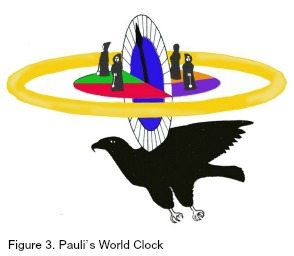
Parallels in Eastern Culture
As previously indicated, prior to 1933, there is no explicit mention of Jung’s rainbow color quaternity. The first reference of it ostensibly appeared in the 1933 Eranos conference which was followed by Jung’s 1934 presentation of Pauli’s dreams. Jung published both papers in the 1940 book The Integration of Personality. During the late 1920s, Jung’s interests began to shift to areas where he could find broader cross-cultural and archetypal consensus for his psychological theories.
By 1928, Jung’s preoccupation with The Red Book and Black Books was winding down and around the same time he received Wilhelm’s manuscript of The Secret of the Golden Flower, which Jung found profoundly meaningful, even synchronistic. In his autobiography, Jung (1961/1989) indicated that he received Wilhelm’s Taoist-alchemical manuscript in 1928 (p. 204). Jung described this serendipitous encounter in a margin note in The Red Book, Jung (2009) wrote:
1928. When I painted this image, which showed the golden well-fortified castle, Richard Wilhelm sent me from Frankfurt the Chinese, thousand-year-old text of the golden castle, the embryo of the immortal body. Ecclesia catholic et protestantes et seclusi in secreto. Aeon finitus. [The Catholic Church and the Protestants and those secluded in secret. The end of an aeon.]. (p. 163)
According to E.A. Bennet (1985), after Jung wrote “The Relations between the Ego and the Unconscious” in 1928 his interest in Chinese thought intensified, which coincided with his reading of Wilhelm’s manuscript on The Secret of the Golden Flower, for which he would later write a commentary. Jung viewed his typology as a western parallel to the Chinese notion of Tao (p. 71).
Around the same time Jung started his dream analysis seminar, which took place between November 7, 1928 and June 25, 1930. During this time period, Jung was still working through a stack of fantasy material that originated both from analytic encounters and cross-cultural studies. In the seminar, Jung indicated that he had already read Zimmer’s Artistic Form and Yoga in the Sacred Images of India, which was instrumental to Jung’s psychological understanding of Eastern traditions and likely informed his reading of the Shri-chakra-sambhara Tantra.
In the foreword of Artistic Form and Yoga in the Sacred Images of India, Joseph Campbell (1984) wrote that, “The crucial moment was of Jung’s reading of Indologist Heinrich Zimmer’s Kunstform und Yoga” (p. xvi). Thus, the importance of this work in regards to Jung’s understanding of mandala symbolism should not be understated. Jung indicated that he first read the book after writing his commentary for Richard Wilhelm’s translation of The Secret of the Golden Flower (1929) and before he met Zimmer: “I first met Heinrich Zimmer at the beginning of the thirties. I had read his fascinating book Kunstform und Yoga and long wished to meet him in person” (Jung as cited in Campbell, 1984, p. xix). Jung actually met Zimmer in May 1932. The fact that Jung (1984) mentioned Zimmer in his dream analysis seminar on February 26, 1930 (p. 492) suggests that he read it around January 1930. Based on the contents of Artistic Form and Yoga in the Sacred Images of India, one can infer that the material informed his dream analysis seminar in regards to Jung’s understanding of Eastern philosophy and symbolism.
In a lecture dated February 12, 1930, Jung discussed the parallels between his typology and Tantric Buddhist symbolism, with reference to the architecture of a Buddhist monastery:
Extraversion means going out through the gates of the courtyard. The inside square is divided like this: and each of the triangles is characterized by a different colour and represents particular philosophical conceptions. Red is the north below, the cardinal points of the horizon being all reversed: A most interesting book, the Bardo Thodol, or the Tibetan Book of the Dead, has been translated recently by an American named Evans-Wentz. There the coloured triangles are explained, and one can identify them with the four functions as we know them in our Western Psychology, the basis of our consciousness, the four qualities of our orientation in space, and therefore identical with cardinal points of the horizon. One leaves the gates through the different functions or habitual attitudes. The man who leaves through the south gate will live in the southern world, and the man who goes out through the gate of thinking will live in the thought world. But when they return, the functions do not matter; only as long as they are outside are the functions important. When he enters the courtyard of the monastery, he approaches the place where all the functions meet; in the very centre he goes into the void where there is nothing. We cannot say that it is unconsciousness, it is a consciousness that is not. (1984, p 467)
The foregoing passage is prescient on three points: 1) Jung (1935/1953) would eventually write a commentary for Evans-Wentz’ (1927/2000) translation of the said work which he apparently read between the date it was published and 1930 (1984, p. 467); 2) the color quaternity—red, yellow, green, and blue—would eventually be imported into his typology; and 3) in 1938 and 1939 Jung gave three lectures on the symbolism of Tantric Buddhism that closely paralleled his abovementioned commentary.
In another lecture in the same month as the previous one, on February 19, 1930, Jung discussed a Tibetan mandala, which he described at length, and he further elaborated on the comparisons between his typological system and the four functions:
I have brought you today the picture of which I spoke last week, the reproduction of the Tibetan mandala. It is a yantra, used for the purpose of concentration upon the most philosophical thought of the Tibetan Lamas. It shows in the innermost circle the diamond wedge or thunderbolt, that symbol of potential energy, and the white light symbolizing absolute truth. And here are the four functions, the four fields of colour, and then the four gates to the world. Then comes the gazelle garden, and finally the ring of fire of desirousness outside. (1984, p. 479)
The passage above demonstrates not only Jung’s interest in the East, but that as early as 1930 he recognized definite parallels between the structure of Western and Eastern mandalas such as the Tibetan yantra. At this time, Jung had already written his commentary for Wilhelm’s The Secret of the Golden Flower, and his attention began to drift to other fields and disciplines (i.e., alchemy, Kundalini yoga, Tantric Buddhism, etc.).
In Artistic Form and Yoga in the Sacred Images of India Zimmer provided extensive commentary on an obscure tantric text called the Shri-chakra-Sambhara Tantra. Zimmer (1926/1984) described this work as a “product of an era in Buddhism’s development in which the main stream of the Buddha doctrine in its course through time acquired an influx from the tributaries of Hinduism [such] that its content became virtually indistinguishable from Hinduism” (p. 81). The Shri-Chakra-Sambhara Tantra has its roots in the diamond vehicle (Vajrayana) doctrine of Tantric Buddhism and consists of a series of instructional mantras—meditational techniques—informed by Tantric doctrine and teachings. Shri Chakra translates to the “Circle of Bliss” (Zimmer, p. 90) and is visualized as a circular mandala consisting of four gates, which evoke Jung’s four functions. The adept or Yogin focuses on the mandala and visualizes a god. The god (Devata) represents the “guru-essence” which could be interpreted psychologically as emanations or projections originating from the background activity of the psyche. Zimmer suggested that the culminating point of the ritual is the attainment of the vajrasattva (diamond essence), which would be analogous to the alchemical lapis. Zimmer added:
Then the adept develops internally the feeling proper to his awareness of the undifferentiated sameness of all phenomena. In the Emptiness that constitutes their essence … he sends out rays in every direction, colored according to the cardinal points–blue, green, red, and yellow [italics added]. Their colors are a surety that his feeling of Total Compassion (karuna) permeates the entire cosmos. (p. 93)
Understandably, the color symbolism would have garnered Jung’s attention when he read the book early in 1930. Around the same time (1930-1931), Jung prepared a two-page manuscript headed “Tantric Texts” which he evidently used in preparation for his lectures at the Eidgenössische Technische Hochschule (ETH), the Swiss Federal Institute of Technology (Shamdasani, 1996, p. xxxiv, n. 66). Shamdasani further indicated that the source material for these manuscripts was Artistic Form and Yoga in the Sacred Images of India (pp. 2-87), wherein can be found Zimmer’s exposition of the Shri-Chakra-Sambhara Tantra.
Jung’s study of the Tantric texts culminated in his 1938 and 1939 lectures at ETH, where he presented psychological commentary on the material in its most lucid form. In these ETH lectures, Jung (1958) provided a historical and etymological overview in accordance with his own hermeneutic understanding. In his commentary, Jung (1958) cited the following passage: “From the Mantra ‘Hum’ rays of blue, green, red and yellow light shoot forth through the four heads of the Devata and gradually fill the whole universe” (p. 48). Jung added:
The Yogin is in the centre, saying “Hum,” the first quality of consciousness, the world principle. The four colours emanate from the centre, the four qualities of consciousness, that is the four functions of consciousness, the four possibilities of consciousness. (p. 48)
Thus, Jung tried to correlate the four colors with his four functions of consciousness, and in a syncretistic turn, proceeded to associate the principal skandhas—the basic building blocks of the phenomenal world in Buddhist tradition—mentioned in the text with his four functions: Rupa skandha (thinking), Vedana skandha (sensation), Samjna skandha (feeling), and Sangskara skandha (intuition). The skandhas are reminiscent of the four classical elements—earth, air, fire, and water—found in ancient philosophy. The text also identifies a fifth skandha or function, Vijnana which Jung equated with a kind of centralized knowledge which united all four functions. Jung (1958) wrote: “The aggregate of cognition (knowledge) is the Buddha, the enlightened diamond essence. The highest essence proceeds out of the four functions as the final result” (p. 51). What seems to emerge from the combination of all functions is the quintessence of Buddha consciousness, made available to us through the mediating service of the Buddhist master, or yogi: “The quaternity is dissolved in the essence of the Yogin, and the fourfold image of consciousness disappears” (p. 51). In his analysis, Jung interpreted the phenomenon as follows:
Then he assimilates all beings into the mandala. One could say that the Yogin hangs like a spider in its web, and draws all beings through the rays of light into the mandala of his personality. He establishes himself as the centre of the world. The light, which emanated from the “Hum,” is withdrawn and absorbed by the Self. (1958, p. 55)
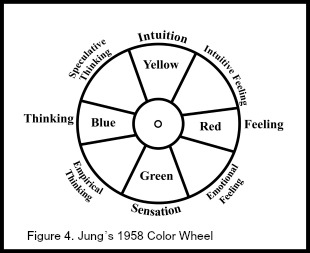
The four colours attributed to the functions are based on certain feeling values. Feeling is red, this is connected with blood and fire, with passion and love which is supposed to be warm and glowing. Sensation is green, this is connected with the earth and perceiving reality. Thinking is white, or blue, cold like snow and Intuition is gold or yellow because it is felt to shine and radiate. (1958, p. 78)
The fact that Jung uses white interchangeably with blue warrants some explanation. In his book Secret Doctrines of the Tibetan Book of the Dead, author and Buddhist scholar Detlef Ingo Lauf (1977) points out that in Buddhism, blue and white are frequently used interchangeably (p. 129). Furthermore, in his commentary for the Tibetan Book of the Dead, Jung (1935/1953) correlated the color white with thinking:
It gradually becomes clearer that all these deities are organized into mandalas, or circles, containing a cross of the four colours. The colours are co-ordinated with the four aspects of wisdom: (1) White = the light-path of the mirror-like wisdom; (2) Yellow = the light-path of the wisdom of equality; (3) Red = the light-path of the discriminative wisdom; (4) Green = the light-path of the all-performing wisdom. (CW 11, para. 850)
Thus, one could say that what was most essential for Jung was not establishing a universally valid psychological schema predicated on color symbolism but empirically demonstrating a semi-regular chromatic pattern which more or less indicated the same psychological meaning. Jung accepted that there would always be some variation in the way the psyche expressed color symbolism.
The Psychoid Factor
Why in modern times does the unconscious select the colors red, yellow, blue, and green? Although addressing such a question presents a difficult task, Jung left behind a few conceptual clues that may provide at least a partial answer. In On the Nature of the Psyche Jung (1947/1954) introduced the concept of the psychoid factor, which one may define as the part of the psyche that is incapable of consciousness and thus only quasi-psychic in nature. In the same work, he employed the analogy of a color spectrum as an analogy to describe his psychoid concept.
Using the analogy of the spectrum, we could compare the lowering of unconscious contents to a displacement towards the red end of the colour band, a comparison which is especially edifying in that red, the blood colour, has always signified emotion and instinct. (CW 8, para. 384)
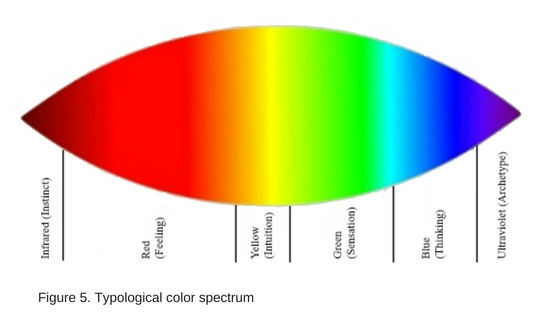
The color symbolism also seems to parallel the alchemical idea of the cauda pavonis, for Jung (1934/1959) suggested that “we may expect the miracle of the cauda pavonis, the appearance of “all Colours,” the unfolding and realization of wholeness, once the dark dividing wall has broken down” (CW 9i, para. 685). Thus, one could associate the color symbolism of Jung’s typology with the appearance of the cauda pavonis—a symbol of wholeness. The cauda pavonis seems to herald the gradual broadening of the total representable bandwidth accessible to the human species. Because Western consciousness occupies but a narrow sliver of this bandwidth of psychic energy, Jung’s assertion that, “Psychic processes therefore behave like a scale along which consciousness ‘slides’” (CW 8, para. 408), suggests that the ego could be viewed as a pointer that can move freely, left and right, on a sliding scale of consciousness and thus could eventually access all the colors of the spectrum analogy alluded to earlier. Viewed in this way, the colors symbolize different modes of consciousness, which probably exceed a mere number of four.
Jung’s typology then, with its emphasis on four functions and four colors should not be viewed as a complete system for it seems possible, even probable, that the human species has the potential to extend the boundaries of consciousness into the psychoid domain and thereby develop heretofore latent functions within the psyche, whose distinct features can only be imagined. Toward the end of his long life, Jung (1956/1963) intimated that more colors, up to seven, could be included into his color scheme: “Consequently the synthesis of the four or seven colours would mean nothing less than the integration of the personality, the union of the four basic functions, which are customarily represented by the colour quaternio blue-red-yellow-green” (CW 14, para. 390).
References
Bennet, E.A. (1985). Meetings with Jung. Zurich, CH: Daimon.
Campbell, J. (1984). Preface. In H. Zimmer, Artistic form and yoga in the sacred images of India (pp. xvii-xxvii). Princeton, NJ: Princeton University Press. (Original work published 1926).
Cornford, F. (1937). Plato’s cosmology: The Timaeus of Plato translated with a running commentary. London: Routledge, & Kegan Paul, Ltd.
Evans-Wentz, W.Y. & Karma-Glin-Pa. (2000). The Tibetan Book of the Dead. New York, NY: Oxford University Press. (Original work published 1927).
Gieser, S. (2005). The innermost kernel: Depth psychology and quantum mechanics. Berlin, Heidelberg, New York: Springer Verlag.
Irwin, J. (1994). The mystery to a solution: Poe, Borges, and the analytic detective story. Baltimore, MD: The Johns Hopkins University Press.
Jung, C.G. (1929). Commentary on The secret of the golden flower. In R.F.C Hull (Trans.), The collected works of C. G. Jung. (Vol. 13). Princeton, NJ: Princeton University Press.
Jung, C.G. (1940). The integration of personality. London: Kegan Paul, Trench, Trubner & Co., LTD.
Jung, C. G. (1948). A psychological approach to the dogma of trinity. In H. Read, M. Fordham, G. Adler, & W. McGuire (Eds.), The collected works of C. G. Jung (R. F. C. Hull, Trans.) (2nd ed., Vol. 11, pp. 106-165). Princeton, NJ: Princeton University Press. (Original work published 1942)
Jung, C. G. (1950). Concerning Mandala Symbolism. In H. Read, M. Fordham, G. Adler & W. McGuire (Eds.), The collected works of C. G. Jung (R. F. C. Hull, Trans.) (2nd ed., Vol. 9i, pp. 355-384). Princeton, NJ: Princeton University Press.
Jung, C. G. (1952). Synchronicity: An acausal connecting principle. In R.F.C Hull (Trans.), The collected works of C. G. Jung. (Vol. 8). Princeton, NJ: Princeton University Press.
Jung, C. G. (1953). Commentary on the Tibetan book of the dead. In R.F.C Hull (Trans.), The collected works of C. G. Jung. (Vol. 11). Princeton, NJ: Princeton University Press. (Original work published 1935)
Jung, C. G. (1954). On the nature of the psyche. In R.F.C Hull (Trans.), The collected works of C. G. Jung. (Vol. 8). Princeton, NJ: Princeton University Press. (Original work published 1947)
Jung, C. G. (1958). Modern psychology: The ETH lectures. Barbara Hannah (Ed.). Unpublished.
Jung, C. G. (1959). A study in the process of individuation. In R.F.C Hull (Trans.), The collected works of C. G. Jung. (Vol. 9i). Princeton, NJ: Princeton University Press. (Original work published 1934)
Jung, C. G. (1963). Mysterium coniunctionis. In R.F.C Hull (Trans.), The collected works of C .G. Jung. (Vol. 14). Princeton, NJ: Princeton University Press. (Original work published 1956)
Jung, C. G. (1969). Psychology and religion. In H. Read, M. Fordham, G. Adler, & W. McGuire (Eds.), The collected works of C. G. Jung (R. F. C. Hull, Trans.) (2nd ed., Vol. 11, pp. 5-105). Princeton, NJ: Princeton University Press. (Original work published 1938)
Jung, C. G. (1970). Psychology and alchemy. In H. Read, M. Fordham, G. Adler, & W. McGuire (Eds.), The collected works of C. G. Jung (R. F. C. Hull, Trans.) (2nd ed., Vol. 12). Princeton, NJ: Princeton University Press. (Original work published 1944)
Jung, C. G. (1971). Psychological types. In H. Read, M. Fordham, G. Adler & W. McGuire (Eds.), The collected works of C.G. Jung (R. F. C. Hull, Trans.) (2nd ed., Vol. 6). Princeton, NJ: Princeton University Press. (Original work published 1921)
Jung, C. G. (1984). Dream analysis: Notes on the seminar given in 1928-1930 by C. G. Jung (W. McGuire, Ed.). Princeton, NJ: Princeton University Press. (Original work published 1938)
Jung, C. G. (1989). Memories, dreams, reflections. Aniela Jaffé (Ed.) (Richard and Clara Winston, Trans.). New York: NY: Vintage Book. (Original work published 1962)
Jung, C. G. (1996). The psychology of Kundalini Yoga: Notes of the seminar given in 1932 by C. G. Jung. Sonu Shamdasani (Ed.). Princeton, NJ: Princeton University Press.
Jung, C. G. (2009). The Red Book: Liber novus. Sonu Shamdasani (Ed.). Philemon Series. New York, NY: W.W. Norton and Company.
Kirsch, T. (2000). The Jungians. Philadelphia, PA: Routledge.
Lauf, D. I. (1977). Secret doctrines of the Tibetan Book of the Dead. Boston, MA: Shambhala.
Zimmer, H. (1984). Artistic form and yoga in the sacred images of India. Princeton, NJ: Princeton University Press. (Original work published 1926)
Images
Hee Choung Yi, “In the Mountains,” (2010), Courtesy: Korean Art Museum Assoc.
Pietro Longhi, “The Alchemist,” (c. 1757). Courtesy: The Yorck Project.
Figure 3: W. Byers-Brown, “World Clock,” (1887). Appeared originally in Synchronicity: The Bridge Between Matter and Mind, (London, 1987), p. 19.
Figure 4: Reconstruction of Jung’s drawing, p. 104, ETH Lectures (1958).



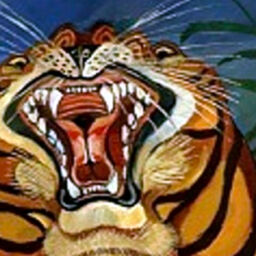
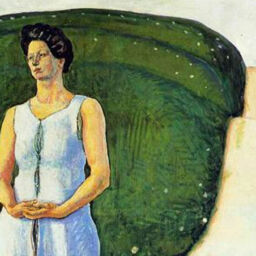
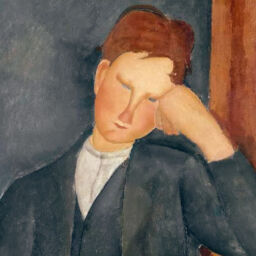
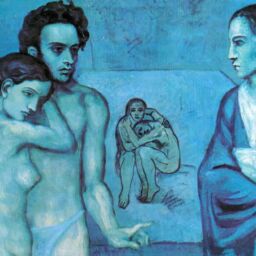
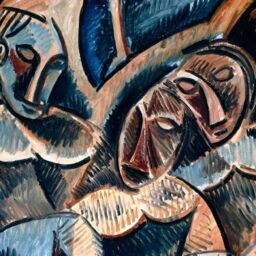
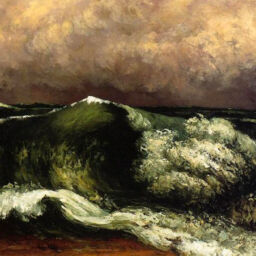
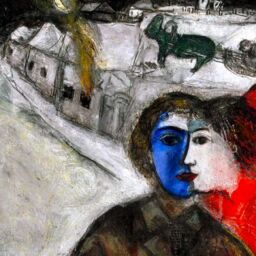
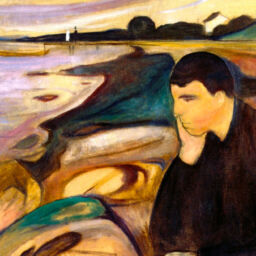
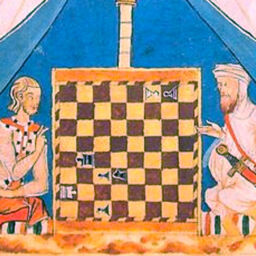
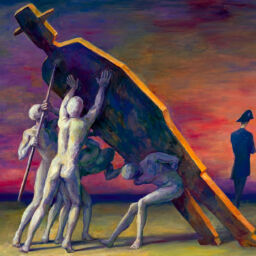
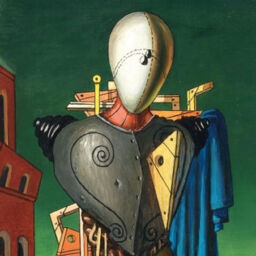
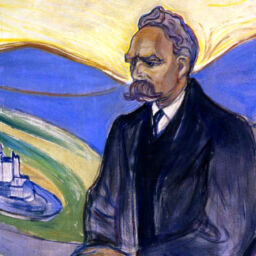
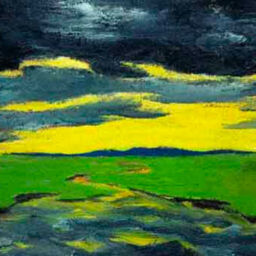
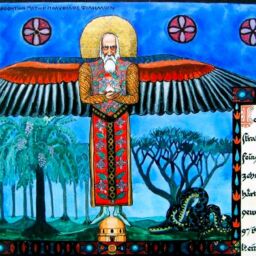
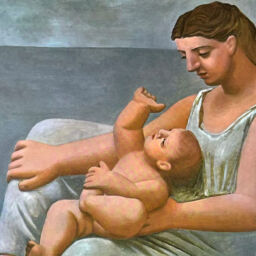
I have only skimmed over a bit of this essay and already it helped me with what I was looking for and gave me insight on something profound in my life which I have wondered about for years. Thank you!
Oh, by the way, I will be in Pacifica for the alchemy seminar coming up the end of August. Love to say hello and shake hands.
Nader
As a painter/writer, I do appreciate your insightful scholarly article. Thank you for sharing.
As you know the color qualities are flexible things–not written in stone; we choose them to represent our feelings, thoughts, intuitions, and perceptions.
My preferred way of looking at intuition is the fire that cooks all the previous functions. I must admit my bias. I am an introvert intuitive type with the inferior function as a sensate.
Here is how I see it: Green: sensation/manifestation, Blue: feeling/formation, Yellow/creation, and finally Red of our being as emanation–the numinous–Spirit. The ultimate lightning that hits us from the blue yonder of consciousness
is Red of spirit and not yellow of thinking.
I am curious as to your informed thoughts.
Thanks again for sharing, that is what life is all about. We stand on each other’s shoulder and take a peek into the darkness of unconscious just like the trail blazer wise Jung that we all love.
I absolutely love this! So much information and patterns to trace. Thank you for providing such an article.
I was wondering if the image of the color spectrum with the functions labeled has an error. Is the red band “feeling” or sensation?
https://typeindepth.org/wp-content/uploads/2015/10/typological-spectrum-Redux-250x.jpg
There is the image link for you.
And here is a nice resource that I am conferring as I read this:
http://www.terrapsych.com/jungdefs.html
Best, IAN!
Erik, thank you for the comment. Jung was very interested in atomic theory and quantum physics. He really didn’t get the mathematics but had a solid grasp of the philosophical implications. I think your thinking is headed in the right direction and thus, is on the mark. In Jung’s essay “On the Nature of the Psyche,” Jung uses the EM spectrum as an analogy to consciousness, which descends, as it were, into the psychoid domain. Jung recognized that what we view as unconscious may, from a different vantage point, actually be conscious. Consciousness after all suggests that somebody or something is conscious “of something.” Your question is highly relevant to the importance of models (and metaphors) in constructing our picture of reality. It’s always changing. Jung viewed analytical psychology as tantamount to a bridge from one weltanschauung to another. Again, thanks for taking the time to read the article. – Kiley
Might Jung being alive today arrive to an even more evolved conclusion as to the comparison of heightened energy states of atoms emitting of photons at defined wave-lengths may also correlate to heighten states of consciousness in the “psychoid domain”? With differing photon wavelengths equaling the spectrum of visible color, might the mind’s energy level also equate to different levels of consciousness?